Researchers from both NASA and the European Space Agency are reported to have independently found evidence of methane in the Martian atmosphere – on Earth, methane is a by-product of life. Methane gas would be destroyed by the Sun’s radiation, so something would need to be replenishing it in the atmosphere. Neither agency has gone public with their findings yet; however, as they’re working to confirm their results with other instruments.
X-43A Goes Hypersonic
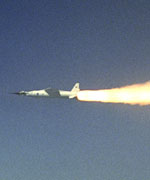
Image credit: NASA
NASA’s second X-43A hypersonic research aircraft flew successfully today, the first time an airbreathing scramjet powered aircraft has flown freely.
The unpiloted vehicle’s supersonic combustion ramjet, or scramjet, ignited as planned and operated for the duration of its hydrogen fuel supply, which lasted about 10 seconds. The X-43A reached its test speed of Mach 7.
“It’s been a great, record-breaking day,” said Larry Huebner, NASA Langley Research Center’s Hyper-X propulsion lead. “We achieved positive acceleration of the vehicle while we were climbing, and maintained outstanding vehicle control. This was a world-record speed for air-breathing flight,” Huebner said.
The flight, originating from NASA’s Dryden Flight Research Center, began at 12:40 p.m. PST, as NASA’s B-52B launch aircraft carrying the X-43A lifted off the runway. The X-43A, mounted on a modified Pegasus booster rocket, was launched from the B-52B just before 2 p.m. The rocket boosted the X-43A up to its test altitude of about 95,000 ft. over the Pacific Ocean, where the X-43A separated from the booster and flew freely for several minutes following scramjet engine operation, in order to gather aerodynamic data.
“Today was a grand-slam in the bottom of the 12th,” said Joel Sitz, NASA Dryden Flight Research Center’s X-43A project manager. “It was fun all the way to Mach 7. We separated the research vehicle from the launch vehicle, as well as separating the real from the imagined,” Sitz said.
NASA’s Langley Research Center, Hampton, Va., and Dryden Flight Research Center, Edwards, Calif., jointly conduct the Hyper-X program. ATK GASL (formerly MicroCraft, Inc.) in Tullahoma, Tenn., built both the vehicle and the engine, and Boeing Phantom Works in Huntington Beach, Calif., designed the thermal protection and onboard systems. The booster is a modified Pegasus rocket built by Orbital Sciences Corp. Chandler, Ariz.
Original Source: NASA News Release
Spirit Begins its Journey to Columbia Hills
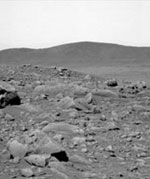
Image credit: NASA/JPL
NASA’s Spirit will begin trekking toward hills on its eastern horizon in the next few days, entering a new phase of the rover’s exploration of Mars just before its prime three-month mission ends and its extended mission begins, rover team members said today.
The range of peaks named “Columbia Hills” is an island of older rock surrounded by a younger volcanic layer which surfaces the plain that Spirit has been crossing, said Dr. Ray Arvidson of Washington University, St. Louis. He is deputy principal investigator for the science payload on both Spirit and its twin rover, Opportunity.
Older rocks may hold evidence of an ancient body of water thought to have once filled Gusev Crater. Spirit landed inside that 150-kilometer-wide (95-mile-wide) crater 12 weeks ago, and the rover’s main task is to find geological clues about whether the region ever had a wet environment. Spirit has spent much of its time since landing driving toward a 200-meter-wide (660-foot-wide) crater nicknamed “Bonneville.” Rover scientists had anticipated that the impact that excavated Bonneville might have ejected rocks old enough to hold clues about whether Gusev held water.
“The ejecta from Bonneville didn’t get excavated from deep enough to get below the volcanic layer,” Arvidson said. So, after finishing an examination of a light-colored rock on the crater’s rim, Spirit will head for the hills.
NASA’s Jet Propulsion Laboratory, Pasadena, Calif., built each of the two Mars Exploration Rovers for a prime mission of 90 martian days of operation. Both rovers are healthy and could operate for several additional months, said JPL’s Matt Wallace, mission manager. A martian day, or sol, lasts about 40 minutes longer than an Earth day, and Spirit’s 82nd sol began on Friday. “Spirit will start driving toward the hills on sol 84 or a little after that,” Wallace said.
Scientists have examined the terrain between Bonneville Crater and Columbia Hills in photographs taken from orbit by NASA’s Mars Global Surveyor and found several features to inspect along the route. These include some small craters and a dark streak apparently left by a whirlwind that removed dust.
Science team member Dr. Larry Crumpler of New Mexico Museum of Natural History, Albuquerque, said, “It won’t be a continuous drive, like a bad road trip. We’ll actually get out and do some touristy things along the way.”
With stops for “traverse science” along the way, the trip of about 2.3 kilometers (1.3 miles) to the near edge of Columbia Hills will probably take 60 to 90 sols, Arvidson said.
Beginning next week and continuing into the extended mission, Spirit’s controllers will switch from working on Mars time – with schedules set to coincide with day or night at Gusev crater – to an Earth time schedule easier to maintain for the long haul. The Opportunity team will shift the following week, Wallace said.
Opportunity is also at the start of a trek. This week, it climbed out of the small impact crater informally named “Eagle Crater” that it had been examining since it landed nine weeks ago. Rocks in an outcrop within the crater have provided evidence that the site was once under flowing water. In coming weeks, Opportunity will drive about 750 meters (nearly half a mile) to a crater nicknamed “Endurance,” where scientists hope to find and examine a thicker set of bedrock layers to learn more about the duration of the region’s wet history.
Before leaving Eagle Crater, Opportunity inspected the soil at five sites in the opposite half of the crater from the outcrop. The target patches show a diversity of particle sizes and shapes on the surface. “We’re seeing the effects of differences in wind speed,” said Bethany Ehlmann, a science team collaborator from the University of Washington, St. Louis. In some patches more than others, winds have removed small particles and left large particles behind, she said.
Spherical gray particles that have been fancifully called blueberries are plentiful in some soil patches higher on the inner slope of the crater than near the center of the crater. A reading by Opportunity’s Moessbauer spectrometer on one of the higher patches found the highest concentration of hematite seen so far in the mission, reported Dr. Goestar Klingelhoefer of the University of Mainz, Germany. He is the lead scientist for that instrument, which is used for identifying iron-containing minerals. The type of hematite Opportunity has been finding usually forms on Earth under wet environmental conditions. JPL, a division of the California Institute of Technology in Pasadena, manages the Mars Exploration Rover project for NASA’s Office of Space Science, Washington, D.C. Images and additional information about the project are available from JPL at http://marsrovers.jpl.nasa.gov and from Cornell University, Ithaca, N.Y., at http://athena.cornell.edu .
Original Source: NASA/JPL News Release
Gregory Olsen Will Be the Next Space Tourist
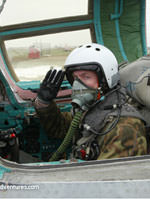
Image credit: Space Adventures
Space Adventures?, Ltd., the world’s leading space experiences company, announced today that American technology entrepreneur Gregory Olsen, Ph.D. will be the next private space explorer client. The company which organized the space flights for the world’s first private space explorers, American businessman Dennis Tito in 2001, and the first African in space, Mark Shuttleworth, in 2002, disclosed Dr. Olsen’s identity and his mission objectives during a press conference today in New York City.
The mission continues Space Adventures? ongoing effort to open the space frontier to more than just career astronauts and cosmonauts. Dr. Olsen is set to begin cosmonaut training next month at the Yuri Gagarin Cosmonaut Training Center in Star City, Russia, with the launch date for the expedition currently planned for April 2005.
Dr. Olsen, CEO of Sensors Unlimited, Inc., Princeton, N.J., commented, ?I hope that by traveling to the International Space Station I can help inspire today’s youth to dream big and to realize that education hard work and a desire to achieve your vision is the magic of America. If I can do it, so can you!?
?We are excited to announce that Dr. Olsen will be the next private space explorer to visit the International Space Station,? said Eric Anderson, president and CEO, Space Adventures. ?He has such a passion for this flight and sees it as an investment in the future. Dr. Olsen not only is committed to motivating young people to study science and technology, but also plans to undertake several science and engineering projects during his flight. That he is paying for his mission privately, in addition to carrying out research and educational programs, makes him his own ?private space program.? We, at Space Adventures, are impressed by the quality and caliber of Dr. Olsen and his plans.?
In conjunction with the Federal Space Agency and the Rocket Space Corporation Energia, Space Adventures continues its commitment to opening the final frontier for private citizens. This innovative project secures the first of four seats made available exclusively to Space Adventures aboard the Soyuz TMA spacecraft traveling to the International Space Station through 2007.
Dr. Olsen, born in 1945 in Brooklyn, N.Y., was raised in a working class family. His father was an electrician and his mother a schoolteacher. He graduated from Fairleigh Dickinson University with a bachelor’s of science and master’s degree in physics. He then went on to graduate from the University of Virginia with a doctorate in materials science. From 1972 to 1983, he worked at RCA Laboratories, now known as the Sarnoff Corporation. In 1984 Dr. Olsen started his first company, Epitaxx and later sold it for $12 million (USD). He founded Sensors Unlimited, Inc. in 1992, later sold it for $700 million (USD) in 2000. Sensors Unlimited develops highly sensitive near-infrared cameras.
Space Adventures, the only U.S. company to have successfully launched private tourists to the International Space Station, headquartered in Arlington, Virginia with an office in Moscow, Russia. It offers a variety of programs such as Zero Gravity, MiG flights, cosmonaut training, space flight qualification programs and reservations on future sub-orbital spacecrafts. The company’s advisory board comprises Apollo 11 moonwalker Buzz Aldrin; shuttle astronauts Kathy Thomton, Robert (Hoot) Gibson, Charles Walker, Nom Thagard, Sam Durrance and Byron Lichtenber; and Skylab astronaut Owen Garriott. For more information, please visit www.spaceadventures.com.
Original Source: Space Adventures News Release
Experiment Will Help Probe “Theory of Everything”
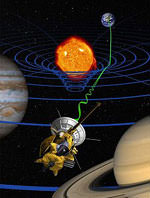
Image credit: NASA/JPL
Sooner or later, the reign of Einstein, like the reign of Newton before him, will come to an end. An upheaval in the world of physics that will overthrow our notions of basic reality is inevitable, most scientists believe, and currently a horse race is underway between a handful of theories competing to be the successor to the throne.
In the running are such mind-bending ideas as an 11-dimensional universe, universal “constants” (such as the strength of gravity) that vary over space and time and only remain truly fixed in an unseen 5th dimension, infinitesimal vibrating strings as the fundamental constituents of reality, and a fabric of space and time that’s not smooth and continuous, as Einstein believed, but divided into discrete, indivisible chunks of vanishingly small size. Experiment will ultimately determine which triumphs.
A new concept for an experiment to test the predictions of Einstein’s relativity more precisely than ever before is being developed by scientists at NASA’s Jet Propulsion Laboratory (JPL). Their mission, which effectively uses our solar system as a giant laboratory, would help narrow the field of vying theories and bring us one step closer to the next revolution in physics.
A House Divided
It may not weigh heavily on most people’s minds, but a great schism has long plagued our fundamental understanding of the universe. Two ways of explaining the nature and behavior of space, time, matter, and energy currently exist: Einstein’s relativity and the “standard model” of quantum mechanics. Both are extremely successful. The Global Positioning System (GPS), for instance, wouldn’t be possible without the theory of relativity. Computers, telecommunications, and the Internet, meanwhile, are spin-offs of quantum mechanics.
But the two theories are like different languages, and no one is yet sure how to translate between them. Relativity explains gravity and motion by uniting space and time into a 4-dimensional, dynamic, elastic fabric of reality called space-time, which is bent and warped by the energy it contains. (Mass is one form of energy, so it creates gravity by warping space-time.) Quantum mechanics, on the other hand, assumes that space and time form a flat, immutable “stage” on which the drama of several families of particles unfolds. These particles can move both forward and backward in time (something relativity doesn’t allow), and the interactions between these particles explain the basic forces of nature — with the glaring exception of gravity.
The stalemate between these two theories has gone on for decades. Most scientists assume that somehow, eventually, a unifying theory will be developed that subsumes the two, showing how the truths they each contain can fit neatly within a single, all-encompassing framework of reality. Such a “Theory of Everything” would profoundly affect our knowledge of the birth, evolution, and eventual fate of the universe.
Slava Turyshev, a scientist at JPL, and his colleagues have thought of a way to use the International Space Station (ISS) and two mini-satellites orbiting on the far side of the sun to test the theory of relativity with unprecedented accuracy. Their concept, developed in part through funding from NASA’s Office of Biological and Physical Research, would be so sensitive that it could reveal flaws in Einstein’s theory, thus providing the first hard data needed to distinguish which of the competing Theories of Everything agree with reality and which are merely fancy chalk-work.
The experiment, called Laser Astrometric Test Of Relativity (LATOR), would look at how the sun’s gravity deflects beams of laser light emitted by the two mini-satellites. Gravity bends the path of light because it warps the space through which the light is passing. The standard analogy for this warping of space-time by gravity is to imagine space as a flat sheet of rubber that stretches under the weight of objects like the sun. The depression in the sheet would cause an object (even a no-mass particle of light) passing nearby the sun to turn slightly as it went by.
In fact, it was by measuring the bending of starlight by the sun during a solar eclipse in 1919 that Sir Arthur Eddington first tested Einstein’s theory of general relativity. In cosmic terms, the sun’s gravity is fairly weak; the path of a beam of light skimming the edge of the sun would only be bent by about 1.75 arcseconds (an arcsecond is 1/3600 of a degree). Within the limits of accuracy of his measuring equipment, Eddington showed that starlight did indeed bend by this amount — and in doing so effectively impeached Newton.
LATOR would measure this deflection with a billion (109) times the precision of Eddington’s experiment and 30,000 times the precision of the current record-holder: a serendipitous measurement using signals from the Cassini spacecraft on its way to explore Saturn.
“I think [LATOR] would be quite an important advance for fundamental physics,” says Clifford Will, a professor of physics at Washington University who has made major contributions to post-Newtonian physics and is not directly involved with LATOR. “We should continue to try to press for more accuracy in testing general relativity, simply because any kind of deviation would mean that there’s new physics that we were not aware of before.”
Solar laboratory
The experiment would work like this: Two small satellites, each about one meter wide, would be launched into an orbit circling the sun at roughly the same distance as Earth. This pair of mini-satellites would orbit more slowly than Earth does, so about 17 months after launch, the mini-satellites and Earth would be on opposite sides of the sun. Even though the two satellites would be about 5 million km apart, the angle between them as viewed from Earth would be tiny, only about 1 degree. Together, the two satellites and Earth would form a skinny triangle, with laser beams along its sides, and one of those beams passing close to the sun.
Turyshev plans to measure the angle between the two satellites using an interferometer mounted on the ISS. An interferometer is a device that catches and combines beams of light. By measuring how waves of light from the two mini-satellites “interfere” with each other, the interferometer can measure the angle between the satellites with extraordinary precision: about 10 billionths of an arcsecond, or 0.01 ?as (micro-arcseconds). When the precision of the other parts of the LATOR design are considered, this gives an overall accuracy for measuring how much gravity bends the laser beam of about 0.02 ?as for a single measurement.
“Using the ISS gives us a few advantages,” Turyshev explains. “For one, it’s above the distortions of Earth’s atmosphere, and it’s also large enough to let us place the two lenses of the interferometer far apart (one lens on each end of the solar panel truss), which improves the resolution and accuracy of the results.”
The 0.02 ?as accuracy of LATOR is good enough to reveal deviations from Einstein’s relativity predicted by the aspiring Theories of Everything, which range from roughly 0.5 to 35 ?as. Agreement with LATOR’s measurements would be a major boost for any of these theories. But if no deviation from Einstein is found even by LATOR, most of the current contenders–along with their 11 dimensions, pixellated space, and inconstant constants–will suffer a fatal blow and “pass on” to that great dusty library stack in the sky.
Because the mission requires only existing technologies, Turyshev says LATOR could be ready to fly as soon as 2009 or 2010. So it may not be too long before the stalemate in physics is broken and a new theory of gravity, space, and time takes the throne.
Original Source: NASA/Science Story
ESA Tests Cargo Ship Tracking System
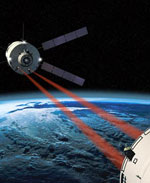
Image credit: ESA
For the first time, the ‘videometer’ (VDM), a new technology device to ensure very precise automatic rendezvous operations between the 20.7 tonne Jules Verne Automated Transfer Vehicle and the ISS, has been successfully tested this month.
State of the art
Based on the design of a star tracker, the Jules Verne videometer, which is the first automatic optical operational system ever used for spacecraft navigation, has been through extensive simulated rendezvous tests. This state of the art rendezvous technology is the crucial part of the new European cargo spaceship to which it gives its specific name of Automated Transfer Vehicle (ATV).
“For the first time, the ATV rendezvous sensors were used successfully in real conditions. And, within their operational domain, they worked exceptionally well,” said ESA ATV engineer Stein E. Strandmoe, who supervised a critical 10-day test campaign.
Precision
For the final rendezvous manoeuvres, the ATV will use its videometer eye-like sensors, combined with additional parallel measurement systems, which allow an automatic docking with an incredible centimetre precision while the spacecraft and the ISS are circling the Earth at 28 000 km/h. “The first European rendezvous spacecraft is expected to dock with ISS next year with the accuracy of the size of a one Euro coin”, said ESA astronaut Jean-Fran?ois Clervoy, senior advisor to the ATV programme.
These built-in automatic capabilities of the ATV must be compatible with the demanding requirements of human spaceflight safety, necessary for the permanently crewed ISS.
Target patterns
The videometer is able to analyse images of its emitted laser beam automatically reflected by passive retroreflectors serving as targets installed on the Station, next to the Russian docking port where the ATV will be attached.
During the last 200 metres of the orbital final approach manoeuvre, the videometer must automatically recognize the retroreflectors target patterns and then calculate the distance and direction to the docking port.
This precise tracking of the relative motion between the two spacecraft as they get closer ? starting at a speed of up to 3.6 km/h ? provides indispensable information to the on-board Guidance, Navigation and Control (GNC) system, which automatically pilots the bus-sized cylindrical ESA cargo ship towards the ISS.
Rendezvous testing
To realistically check the videometer capabilities ? in targeting and acquisition ? the tests were conducted in a hi-tech ship hull research facility at the French defence agency ‘D?l?gation G?n?rale pour l’Armement’ (DGA), located in Val-de-Reuil, 100 km west of Paris. A contract between ESA and DGA will allow further ATV rendezvous testing, including during the Jules Verne flight, if needed.
Inside an exceptional building, 600 metres in length, a 120 000 kg mobile platform, able to ride on 550 metre long rails, enabled the simulation of a continuous approach between the two space vehicles from a range of several hundred metres to within almost docking distance. On the platform, a set of passive rendezvous targets (retroreflectors), identical to the ones to be installed on ISS, were facing the videometer which was mounted on an articulated robotic arm (with six degrees of freedom) representing the ATV motion.
This seven metre high mobile arm was used to simulate the angular movements of the ATV to check if the videometer was still able to target the ISS retroreflectors and provide the information to the ATV control system necessary to adjust its trajectory accordingly.
First time success
The results of the test campaign showed that the whole videometer system ? that is to say the laser illuminator and the image analyser of the reflected laser beams ? was able to continuously track the simulated ISS platform from a distance of 313 metres, right up close to docking. “We have stable acquisition and tracking in its entire operating domain,” said Stein Strandmoe. At greater distances, Jules Verne will use a relative GPS reference system to get closer to the Station.
“The most surprising thing was that the sensors were almost undisturbed when we tried to fool them with other reflecting surfaces or other lights that could interfere with rendezvous targets in the ISS background,” said Strandmoe. “It’s amazing how the videometer, as a totally new development, proved to be such a robust system. I was quite surprised that it worked so well the first time it was tested!”
Original Source: ESA News Release
Cassini’s New Saturn Movie
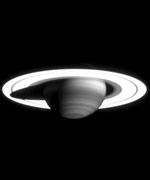
Image credit: NASA/JPL
Wind-blown clouds and hazes high in Saturn’s atmosphere are captured in a movie made from images taken by the Cassini narrow angle camera between Feb. 15 and Feb. 19, 2004. The images were made using a filter sensitive to a narrow range of wavelengths centered at 889 nanometers where methane in Saturn’s atmosphere absorbs sunlight. Cassini was 65.6 million kilometers (40.7 million miles) from Saturn when the images, reduced in size by a factor of two onboard the spacecraft, were taken. The resulting image scale is approximately 786 kilometers (420 miles) per pixel.
This is the first movie ever made showing Saturn in these near-infrared wavelengths. The movie, consisting of 30 stacked images, spans five days and captures five complete but non-consecutive Saturn rotations. The direction of motion is prograde, or left to right. Each 10.6 hour Saturn rotation is evenly sampled by six images. In `movie time’, there is 0.25 second between each of the six images in an individual rotation, and one second between rotations. After each rotation sequence, the planet can be seen to grow slightly in the field of view.
Cassini has three filters designed to sense different heights of clouds and hazes in Saturn’s atmosphere. Any light detected by cameras using the 889 nanometer filter is reflected very high in the atmosphere, before the light is absorbed. Thus, the bright areas in these images represent high hazes and clouds near the top of Saturn’s troposphere.
In the movie, atmospheric motions can be seen most clearly in the equatorial region and at other southern latitudes as well. Saturn’s equatorial region seems disturbed in the same way that it has been for the past decade, as revealed by observations from the Hubble Space Telescope. Researchers have speculated that the bright cloud patterns there are associated with water-moist convection arising from a deeper atmospheric level where water condenses on Saturn, and rising to levels at or above the visible cloud tops. Close analysis of future images by scientists on the Cassini-Huygens mission should help determine if this is the case.
Saturn’s rings are extremely overexposed in these images. Because the range of wavelengths for this spectral filter is narrow, and because most of this light is absorbed by Saturn, the disk of Saturn is inherently faint and the exposures required are quite long (22 seconds). The rings do not strongly absorb at these wavelengths, and so reflect more light and are overexposed compared to the atmosphere. Orbiting moons in the images were manually removed during processing.
The Cassini-Huygens mission is a cooperative project of NASA, the European Space Agency and the Italian Space Agency. The Jet Propulsion Laboratory, a division of the California Institute of Technology in Pasadena, manages the Cassini-Huygens mission for NASA’s Office of Space Science, Washington, D.C. The imaging team is based at the Space Science Institute, Boulder, Colorado.
For more information about the Cassini-Huygens mission, visit http://saturn.jpl.nasa.gov and the Cassini imaging team home page, http://ciclops.org.
Original Source: CICLOPS News Release
Time to Help Save Hubble
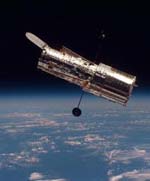
Expressing the sense of the House of Representatives relating to the extraordinary contributions resulting from the Hubble Space Telescope to scientific research and education, and to the need to reconsider future service missions to the Hubble Space Telescope.
Whereas discoveries from the Hubble Space Telescope have dominated space science news over the last 10 years;
Whereas the Hubble Space Telescope has provided proof of black holes, insights into the birth and death of stars, spectacular views of Comet Shoemaker-Levy 9’s collision with Jupiter, the age of the Universe, and evidence that the expansion of the Universe is accelerating;
Whereas the inspiring scientific discoveries from the Hubble Space Telescope reach millions of students each year and have been important in encouraging students to study the sciences;
Whereas installation of new instruments in 1997 and 2002 improved Hubble’s observational capabilities by a factor of 10;
Whereas the 2000 National Academy of Sciences Decadal Survey endorsed a plan to maintain the Hubble Space Telescope until 2010;
Whereas the Hubble Space Telescope has been the National Aeronautics and Space Administration’s most scientifically productive mission, accounting for 35 percent of all National Aeronautics and Space Administration discoveries in the last 20 years;
Whereas the demand for research time on the Hubble Space Telescope in 2003 was approximately 8 times that available;
Whereas approximately $200,000,000 worth of instruments have largely been built, including scientific instruments that would provide significant improvements in Hubble’s scientific power and including replacement gyroscopes and batteries, which could keep the telescope in operation until 2011 or 2012 and make the Hubble Space Telescope’s final years its most scientifically capable and productive;
Whereas the distinguished panel that studied scientific priorities for ultraviolet and optical astronomy in 2003 considered the continued operation of the Hubble Space Telescope by means of the SM-4 servicing mission to be its highest priority; and
Whereas the American Astronomical Society, the largest professional scientific association for astronomers and astrophysicists, believes a panel of experts should review the decision to limit prematurely the lifespan of the Hubble Space Telescope: Now, therefore, be it
Resolved, That the House of Representatives–
(1) recognizes the extraordinary contributions resulting from the Hubble Space Telescope to scientific research and education;
(2) strongly recommends that the Administrator of the National Aeronautics and Space Administration appoint an independent panel of expert scientists and engineers inside and outside of the National Aeronautics and Space Administration to examine all possible options for safely carrying out the planned servicing mission to the Hubble Space Telescope; and
(3) expresses its strong sentiment that the National Aeronautics and Space Administration should continue all planning, preparation, and astronaut training activities for the SM-4 servicing mission without interruption until the expert panel issues its report and until the National Aeronautics and Space Administration provides a timetable of compliance with recommendation R6.4-1 of the Columbia Accident Investigation Board report, which calls for `a fully autonomous capability for all missions to address the possibility that an International Space Station mission fails to achieve the correct orbit, fails to dock successfully, or is damaged during or after undocking’, since National Aeronautics and Space Administration compliance with the recommendation will allow both a Hubble servicing mission and missions to the International Space Station to be carried out safely.
Learning How to Live Off the Land
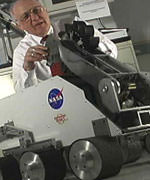
Image credit: NASA
Sludge. That’s what most people think of when they envision the gray, powdery soil ? called regolith ? covering the airless surface of the Moon. Not Dr. Mike Duke. He sees gold.
Gold in the form of rocket propellant, power, and even breathable air ? all things that will be as valuable as gold to the first Moon-dwellers.
“As a young man, I wanted to go to the Moon,” says 68-year-old Duke, who was one of the first geologists to study samples from Moon rocks collected during the Apollo missions in the 1970s. I may be too old to make the trip when Americans return to the Moon, but the research I am leading will help the first lunar settlers take what’s there and make something practical.”
Duke is an expert in what space explorers call “in-situ resource utilization” or ISRU ? living off the land of an alien world. In 2003, he was named director of the Center for Commercial Applications of Combustion in Space Centers at the Colorado School of Mines in Golden ? one of NASA’s 15 Research Partnership. He joined the partnership center in 2000 and uses skills he honed during his 25-year career as a NASA geologist. In 1965, he was a candidate for NASA’s Scientist Astronaut Program, made the finals, but wasn’t selected to fly. He went on to help other space explorers, from 1976 until 1990 as the director of the Solar System Exploration Division and from 1990 to 1995 as the chief scientist for the Human Exploration Program ? both at NASA’s Johnson Space Center in Houston.
“We can’t take everything to the Moon or Mars with us,” Duke says. “Today, it would take about 100,000 dollars to get a couple pounds of material moved from Earth to the Moon. So making propellant on the Moon would make trips back to Earth or on to Mars less expensive.”
Before you can process the lunar soil and turn it into rocket propellant or other useful materials, you have to figure out a way to mine it. For four years, Duke and a team of graduate students have been working on a robotic excavator. They built a prototype that weighs around a hundred pounds and has a chassis similar to the NASA rovers ? Spirit and Opportunity ? on Mars now. An arm-like boom extends from the vehicle’s front end. It sports a wheel of buckets that scoop up soil. The dirt falls out of the buckets and into a conveyer system that takes it up the side of the boom. The arm moves from side to side and excavates a swath of dirt one and a half feet wide, the width of the excavator.
The current model can dig up several hundred pounds of dirt in an hour, but the team is working to increase the excavation rate. They also are designing a system to shoot the dirt from the excavator to a “lunar dump truck.” The truck would carry the soil to a processing facility to extract hydrogen ? a component of the fuel that powers the Space Shuttle and could fuel a lunar rocket.
Duke and his students also have completed a model that identifies lunar resources and their potential uses. The team even examined how a company could make money on the Moon, and came up with a scenario for a “space filling station” ? where in-space tugs would be loaded with lunar-made propellants and used to boost communications satellites to high orbits.
Why is Duke concerned with space business ventures? Collaborating with industry to explore the solar system is one of the goals of the Research Partnership Centers managed by the Space Partnership Development Program at NASA’s Marshall Space Flight Center in Huntsville, Ala., for NASA’s Office of Biological and Physical Research, Washington.
“NASA’s Research Partnership Centers bring together industry, academia and government to advance exploration in space,” says Duke. “These collaborations are an effective way to create new technologies at lower costs.”
One of the aspects Duke most enjoys about his job is creating new opportunities for students to conduct original research that will help advance space exploration.
“I studied geology at Caltech because I loved California ‘s mountains and deserts,” recalls Duke, a Los Angeles native who earned his doctorate degree in 1963 from the California Institute of Technology in Pasadena. “But the university was a hotbed for planetary science, and my professors inspired me to study the geology of meteorites and the Moon. I want my students to become the next generation of scientists and engineers who take America to the Moon and beyond.”
One recent project that students helped design was the water mist investigation, conducted in space to examine how to fight fire with a fog-like mist of water ? instead of large amounts of water that can damage computers and other equipment. The STS-107 Space Shuttle crew completed the experiment during their January 2003 flight.
Although the experiment equipment was lost in the Columbia accident, the team received data from video sent back to Earth during the mission. They are using the data to design a space fire extinguisher for contained environments such as spacecraft, space habitats and submarines.
For more information visit:
Center for Commercial Applications of Combustion in Space
http://www.mines.edu/research/ccacs/
Office of Biological and Physical Research
http://spaceresearch.nasa.gov/
Space Partnership Development Program
http://www.spd.nasa.gov
Original Source: NASA News Release
Chandra Sees Magnesium in an Exploded Star
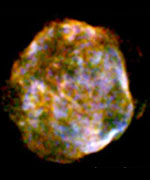
Image credit: Chandra
The Chandra image of N49B, left, the remains of an exploded star, shows a cloud of multimillion-degree gas that has been expanding for about 10,000 years. A specially processed version of this image, right, reveals unexpectedly large concentrations of the element magnesium, shown in blue.
Magnesium, created deep inside the star and ejected in the supernova explosion, is usually associated with correspondingly high concentrations of oxygen. However, the Chandra data indicate that the amount of oxygen in N49B is not exceptional. This poses a puzzle as to how the excess magnesium was created, or, alternatively, how the excess oxygen has escaped detection.
The amount of magnesium in N49B is estimated to be about equal to the total mass of the Sun. Since the Sun contains only about 0.1 percent of magnesium by mass, the total mass of magnesium N49B is about a thousand times that in the Sun and its planets.
Magnesium, the eighth most abundant material in the Earth’s crust, is a mineral needed by every cell of our bodies. It helps maintain normal muscle and nerve function, keeps heart rhythm steady, and bones strong. It is also involved in energy metabolism and protein synthesis. Fortunately for us, and thanks to stars such as the one that produced N49B, there is an abundant supply of magnesium in the Universe.
NASA’s Marshall Space Flight Center in Huntsville, Ala., manages the Chandra program. ( NASA/CXC/Penn State/S. Park et al. )
Original Source: Chandra News Release
